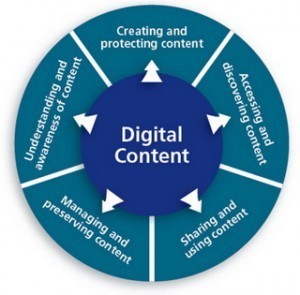Getting Cozy with Your Content
by Reid Rousseau
Knowing and understanding your content is an ever evolving and essential component of ensuring the longevity and success of corporate information management initiatives—be they archiving, digital asset management (DAM), content management (CMS) or records management (RIM). Whether you are approaching this task from a “first date” or “decades-long marriage” perspective, it is important to realize that no matter how well you may think you know your content, it is worth taking a step back to formally understand what you have, and how it fits into the big picture of your business strategy and goals.
 Performing an Asset Audit is a process that will allow you take inventory of the full library of asset types owned and managed in an enterprise, to discover how they are produced, interrelated, stored, accessed, and distributed. It is the crucial first step towards intimately understanding your assets from a 360-degree perspective before embarking on any of the intrinsic next phases of an information management initiative.
Performing an Asset Audit is a process that will allow you take inventory of the full library of asset types owned and managed in an enterprise, to discover how they are produced, interrelated, stored, accessed, and distributed. It is the crucial first step towards intimately understanding your assets from a 360-degree perspective before embarking on any of the intrinsic next phases of an information management initiative.
Only when you have comprehensive documentation of your assets, can you begin to design a holistic metadata strategy that reflects your asset inventory and supports asset categorization and discovery for end users. The asset audit is also a critical reference document to be able to scope, design, select, and deploy technology systems that will appropriately manage your assets and evolve in alignment with your ever changing asset and business needs.
Optimity’s Approach
At Optimity Advisors we have found that conducting an Asset Audit often uncovers insights that may be overlooked by more common high-level reviews, as on-the-ground teams may be unfamiliar with the steps necessary to fully capture the content requirements imperative for successfully pursuing information management initiatives. In reality, it is not plug and play … it’s so much more.
We recommend organizing your approach to an Asset Audit by identifying a high-level category framework, and fleshing out specific attributes per category that describe your organization’s content needs.
High-level categories may include but are not limited to:
Asset Descriptive Characteristics
Asset Technical Characteristics
Asset Workflow & Technology Touch Points
Asset Ownership
Asset Accessibility
Technology Applications & Systems Managing Assets
Asset Rights Information
Once populated, a properly conducted Asset Audit template should identify valuable insights about your organization’s physical and digital assets, their workflows, and the people, process, and technology ecosystem that support them.
Typical information identified in a thorough Asset Audit include:
Interrelationships among assets, people, processes, and technology
Workflow inefficiencies
File relationships that could be leveraged to facilitate asset discovery
Gaps in asset ownership and stewardship
Assets not managed by current technology but having the potential to be
Any non-compliance within the initiative’s policies and procedures
Optimity’s asset-first approach provides the backbone to any corporate information management initiative by guaranteeing a 360-degree snapshot of an organization’s content. The resulting Asset Audit should become a core document that guides all key elements of a holistic information management strategy, ensuring that it is scalable to support ongoing and future content and business needs.
Reid Rousseau is a Senior Associate at Optimity Advisors.
Rod Collins's Blog
- Rod Collins's profile
- 2 followers




